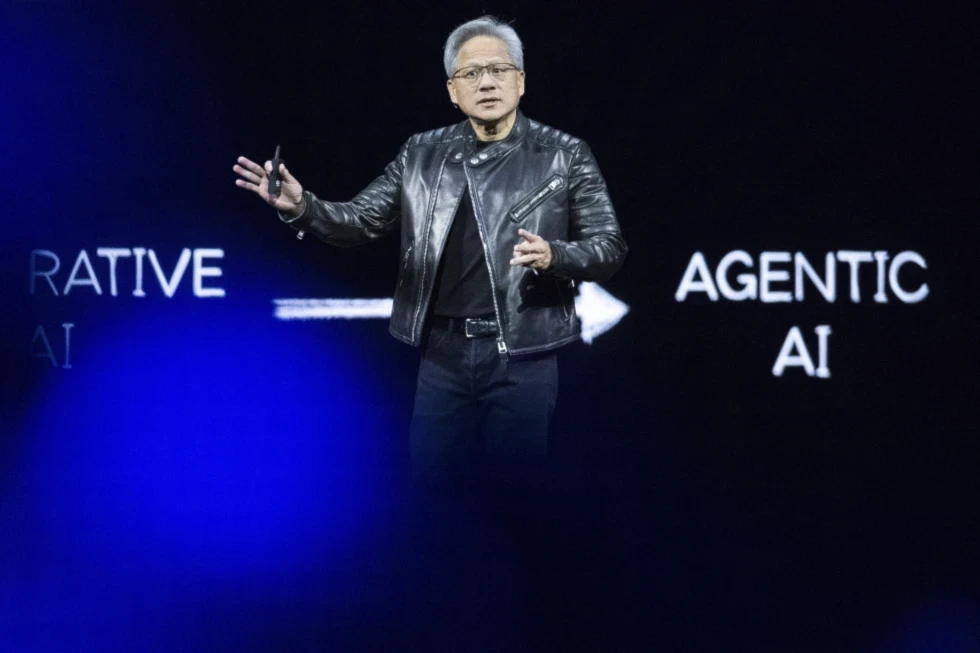Nvidia to build Taiwan’s first AI supercomputer with Foxconn, TSMC
Nvidia unveils plans for Taiwan's first AI supercomputer at Computex 2025, partnering with Foxconn, TSMC, and the government to boost AI infrastructure.
-

Nvidia CEO Jensen Huang talks during the keynote address of Nvidia GTC Tuesday, March 18, 2025, in San Jose, Calif. (AP Photo/Nic Coury)
Nvidia CEO Jensen Huang has announced plans to help build Taiwan’s first AI supercomputer, marking a major milestone in the island’s growing role in global artificial intelligence infrastructure. The project was revealed during Huang’s keynote address on the eve of Computex 2025, Taiwan’s largest tech exhibition.
Huang stated that Nvidia will collaborate with Taiwanese tech powerhouses Foxconn and TSMC, alongside the government, to develop the AI supercomputer. He emphasized the importance of creating a robust ecosystem for artificial intelligence, calling the initiative “critical” for maintaining global competitiveness.
“Having a world-class AI infrastructure in Taiwan is really important,” Huang told the audience.
This joint venture is expected to strengthen Taiwan’s position at the forefront of AI hardware development, with the supercomputer serving both domestic innovation and broader regional applications.
Computex 2025 focuses on AI hardware breakthroughs
Held annually, Computex has drawn leading semiconductor and AI players from around the world. This year’s edition highlights breakthroughs in AI computing, with a particular focus on integrating AI beyond data centers, into personal devices, robotics, and autonomous vehicles.
Executives from Qualcomm, MediaTek, and Foxconn are scheduled to deliver keynotes exploring the next frontier of AI infrastructure in Asia. According to market intelligence firm Counterpoint, the industry is rapidly shifting toward what it calls “Agentic AI” and “Physical AI,” trends poised to transform how humans interact with machines.
Taiwan remains a global hub for advanced chip production, especially those used in cutting-edge AI applications. From smartphones to servers that power platforms like ChatGPT, Taiwan’s chip output is central to the digital economy.
Despite challenges such as US tariffs and global supply chain disruptions, Taiwan’s semiconductor industry continues to power much of the world’s computing infrastructure. The development of a domestic AI supercomputer would not only boost local capabilities but also solidify Taiwan’s role as a global technology leader.
Changes in AI landscape amid global competition
Nvidia’s expansion in Taiwan, a key US ally in the semiconductor space, comes at a time of increasing pressure on global chip dominance, particularly as Huawei accelerates its push to compete with Nvidia on AI performance.
Huawei is preparing to test its new Ascend 910D AI processor, specifically designed to challenge Nvidia’s H100, a cornerstone chip used in the training of large AI models. Despite being blacklisted by the US and subject to severe export controls, Huawei remains resilient, courting domestic tech firms to evaluate the 910D’s capabilities. Sample chips are expected by late May, although mass deployment remains months away.
The 910D is part of Huawei’s strategy to secure a foothold in AI infrastructure, using multi-chip packaging to boost performance. While the chip is more power-hungry than Nvidia’s equivalents, it presents a viable domestic alternative for Chinese firms increasingly cut off from US-made hardware.
Huawei has already developed systems like CloudMatrix 384, linking 384 Ascend 910C chips to achieve high-performance AI workloads. In tandem, Beijing has encouraged state-linked developers to adopt locally produced chips, especially in public-sector data centers.
Still, Huawei faces bottlenecks in scaling production due to its limited access to advanced manufacturing tools and components like high-bandwidth memory (HBM), areas where Nvidia remains firmly ahead. Meanwhile, the US continues to tighten export restrictions, most recently limiting Nvidia’s H20 chip sales to China, opening further space for Chinese alternatives.
Expert outlook: AI’s transition from research to real-world use
Paul Yu, a tech analyst at Witology Markettrend Research Institute, said the industry is entering a pivotal phase.
“Over the past two and a half years, significant investment has driven rapid advances in AI technology,” Yu told the Agence-France Presse (AFP). “2025 to 2026 will be the crucial period for transitioning AI model training into profitable applications.”
As Taiwan accelerates its investment in AI infrastructure, the new supercomputer project reflects both national ambition and the island’s strategic importance in shaping the future of artificial intelligence.
Nvidia’s announcement is seen as a calculated move to reinforce its dominance in AI computing hardware, especially in a region under increasing geopolitical scrutiny. Taiwan’s semiconductor sector remains vital to the global tech economy, and a focal point of US-China tensions.
By deepening partnerships with Foxconn and TSMC, Nvidia is solidifying its position not only as a hardware provider but as a strategic ally in the West’s effort to maintain technological leadership in the face of Beijing’s accelerated AI ambitions.
Analysts expect the AI supercomputer to power new commercial and academic applications across East Asia, reinforcing Taiwan’s role as a regional AI hub.

 5 Min Read
5 Min Read










